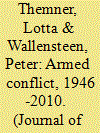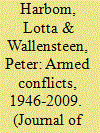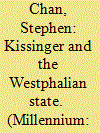|
|
|
Sort Order |
|
|
|
Items / Page
|
|
|
|
|
|
|
| Srl | Item |
| 1 |
ID:
109916


|
|
|
|
|
| Publication |
2011.
|
| Summary/Abstract |
In 2010, UCDP recorded 30 active armed conflicts (i.e. with a minimum of 25 battle-related deaths). This is a substantial reduction in relation to the 36 conflicts registered for 2009. A drop of this magnitude has only been reported four times previously in the post-1946 period. However, only in two of these instances was this part of a general downward trend. Thus no major inferences should be drawn, except perhaps that the reduction in conflicts in Africa seems to be part of a trend. At 30 in 2010, the number of active conflicts is at its lowest level since 2003. Furthermore, the number of wars (1,000 or more battle-related deaths) declined from six in 2009 to four in 2010. The most intense war in terms of fatalities was in Afghanistan. Eight of the armed conflicts listed for 2009 were not active in 2010, but during the year two new conflicts erupted - Mauritania and Tajikistan - both involving rebel groups that had previously fought in neighbouring countries. Only two peace agreements were concluded during the year. While this is one more than 2009, it is decidedly below the annual average for the post-Cold War period.
|
|
|
|
|
|
|
|
|
|
|
|
|
|
|
|
| 2 |
ID:
098418


|
|
|
|
|
| Publication |
2010.
|
| Summary/Abstract |
In 2009, UCDP recorded 36 active armed conflicts, down by one from 2008. Having remained fairly stable over the past few years, the number of armed conflicts is now substantially lower than during the peak years of the early 1990s. But compared to the early years of this decade, the figure has increased by 24%. Six of the conflicts reached the level of war (more than 1,000 battle-related deaths) in 2009, up by one from 2008. No interstate conflict was recorded, but seven intrastate conflicts were internationalized, in the sense that one or both of the conflict parties received troops support from an external state. The most intense war in terms of fatalities was that in Sri Lanka. Eight of the armed conflicts listed for 2008 were not active in 2009, but during the year, one entirely new conflict erupted in Myanmar (Kokang), two were restarted by previously recorded actors in Angola (Cabinda) and in Rwanda and four previously recorded conflicts were restarted by new actors in Central African Republic, India (Bodoland), Nigeria and Yemen. Only one peace agreement was concluded during the year, which is decidedly lower than the annual average recorded for the past 20 years.
|
|
|
|
|
|
|
|
|
|
|
|
|
|
|
|
| 3 |
ID:
141223


|
|
|
|
|
| Summary/Abstract |
Despite seeming to express an openness towards the world, Henry Kissinger’s new book, World Order: Reflections on the Character of Nations and the Course of History, is in fact deeply conservative in terms of his adherence to the Westphalian state as the desirable actor in International Relations, and almost as a normative condition of the world’s architecture. Kissinger sketches his views of different regions of the world, but these views are derived from his past experience more than a nuanced and forward-looking view of a rapidly changing world.
|
|
|
|
|
|
|
|
|
|
|
|
|
|
|
|
|
|
|
|
|